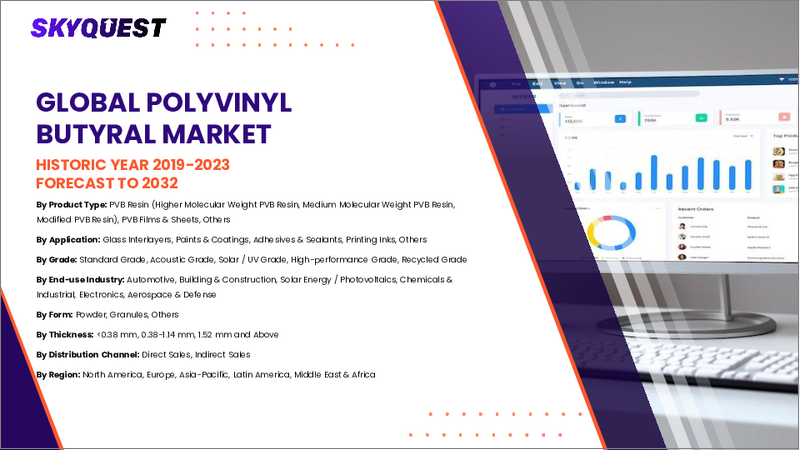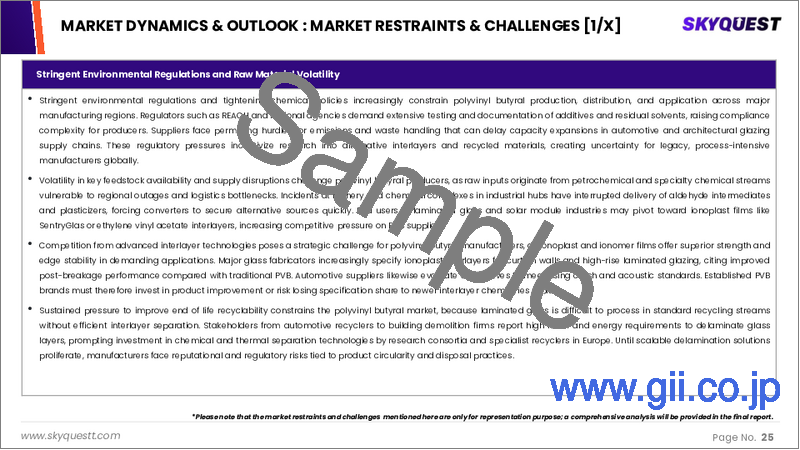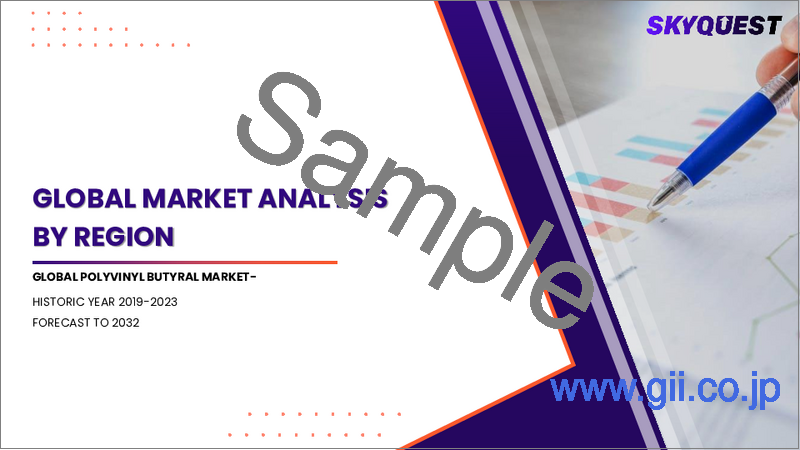|
|
市場調査レポート
商品コード
1670701
ポリビニルブチラールの市場規模、シェア、成長分析:用途別、最終用途産業別、地域別 - 産業予測 2025~2032年Polyvinyl Butyral Market Size, Share, and Growth Analysis, By Application (Film & Sheets, Paints & Coatings), By End-Use Industry (Automotive, Construction), By Region - Industry Forecast 2025-2032 |
||||||
|
|||||||
| ポリビニルブチラールの市場規模、シェア、成長分析:用途別、最終用途産業別、地域別 - 産業予測 2025~2032年 |
|
出版日: 2025年02月28日
発行: SkyQuest
ページ情報: 英文 195 Pages
納期: 3~5営業日
|
全表示
- 概要
- 目次
ポリビニルブチラール(PVB)市場規模は2023年に56億2,000万米ドルと評価され、2024年の59億8,000万米ドルから2032年には98億2,000万米ドルに成長し、予測期間(2025-2032年)のCAGRは6.4%で成長する見通しです。
自動車産業と建設産業がPVB市場の堅調な成長を牽引しており、その理由はPVBの優れた耐久性、化学的安定性、遮音性にあります。PVBフィルムは耐衝撃性、耐破壊性により建物内の事故を防止し、住宅・商業分野での合わせガラス需要の増加につながっています。米国では最近、1兆2,000億米ドル規模のインフラ整備法案が提出され、建設活動が活発化することが予想され、建築用途、特に空港や鉄道プロジェクトでのPVB採用がさらに促進されます。クラレのライフサイクルアセスメントに代表される持続可能性の革新はPVB製品の改善点を浮き彫りにしており、イーストマンが最近発表した鳥類に安全なPVB中間膜は、美観を犠牲にすることなく現代建築の標準にアピールする新たなデザインオプションを提供しています。
目次
イントロダクション
- 調査の目的
- 調査範囲
- 定義
調査手法
- 情報調達
- 二次と一次データの方法
- 市場規模予測
- 市場の前提条件と制限
エグゼクティブサマリー
- 世界市場の見通し
- 供給と需要の動向分析
- セグメント別機会分析
市場力学と見通し
- 市場概要
- 市場規模
- 市場力学
- 促進要因と機会
- 抑制要因と課題
- ポーターの分析
主な市場の考察
- 重要成功要因
- 競合の程度
- 主な投資機会
- 市場エコシステム
- 市場の魅力指数(2024年)
- PESTEL分析
- マクロ経済指標
- バリューチェーン分析
- 価格分析
ポリビニルブチラール市場規模:用途別& CAGR(2025-2032)
- 市場概要
- フィルムとシート
- 塗料とコーティング
- 接着剤
- その他
ポリビニルブチラール市場規模:最終用途産業別& CAGR(2025-2032)
- 市場概要
- 自動車
- 建設
- 電子機器・電気機器
- その他
ポリビニルブチラール市場規模& CAGR(2025-2032)
- 北米
- 米国
- カナダ
- 欧州
- ドイツ
- スペイン
- フランス
- 英国
- イタリア
- その他欧州地域
- アジア太平洋地域
- 中国
- インド
- 日本
- 韓国
- その他アジア太平洋地域
- ラテンアメリカ
- ブラジル
- その他ラテンアメリカ地域
- 中東・アフリカ
- GCC諸国
- 南アフリカ
- その他中東・アフリカ
競合情報
- 上位5社の比較
- 主要企業の市場ポジショニング(2024年)
- 主な市場企業が採用した戦略
- 最近の市場動向
- 企業の市場シェア分析(2024年)
- 主要企業の企業プロファイル
- 企業の詳細
- 製品ポートフォリオ分析
- 企業のセグメント別シェア分析
- 収益の前年比比較(2022-2024)
主要企業プロファイル
- Eastman Chemical Company(United States)
- Sekisui Chemical Co., Ltd.(Japan)
- Kuraray Co., Ltd.(Japan)
- Chang Chun Petrochemical Co., Ltd.(Taiwan)
- EVERLAM(Germany)
- DuPont de Nemours, Inc.(United States)
- Solutia Inc.(United States)
- Huakai Plastic(Chongqing)Co., Ltd.(China)
- Kingboard Chemical Holdings Ltd.(Hong Kong)
- Tiantai Kanglai Industrial Co., Ltd.(China)
- Jiangsu Daruihengte Technology & Science Co., Ltd.(China)
- Zhejiang Pulijin Plastic Co., Ltd.(China)
- Anhui Wanwei Group Co., Ltd.(China)
- Qingdao Jinuo New Materials Co., Ltd.(China)
- 3M Company(United States)
- Shenzhen Lifeng Plastic Products Co., Ltd.(China)
- Wuhan Honghui New Material Co., Ltd.(China)
- Jiangxi Rongxin New Materials Co., Ltd.(China)
- Guangzhou Aojisi New Material Co., Ltd.(China)
- Zhejiang Decent Plastic Co., Ltd.(China)
結論と提言
Polyvinyl Butyral Market size was valued at USD 5.62 billion in 2023 and is poised to grow from USD 5.98 billion in 2024 to USD 9.82 billion by 2032, growing at a CAGR of 6.4% during the forecast period (2025-2032).
The automotive and construction industries are driving robust growth in the polyvinyl butyral (PVB) market, attributed to PVB's exceptional durability, chemical stability, and sound insulation properties. PVB films prevent accidents in buildings with their anti-shocking and anti-break-in features, leading to increased demand for laminated glass solutions in residential and commercial sectors. The recent $1.2 trillion U.S. infrastructure bill is expected to amplify construction activity, further boosting PVB adoption in architectural applications, particularly in airport and railway projects. Innovations in sustainability, such as Kuraray's Life Cycle Assessment, highlight areas for improvement in PVB products, while Eastman's recent launch of bird-safe PVB interlayers offers new design options, appealing to modern architectural standards without sacrificing aesthetics.
Top-down and bottom-up approaches were used to estimate and validate the size of the Polyvinyl Butyral market and to estimate the size of various other dependent submarkets. The research methodology used to estimate the market size includes the following details: The key players in the market were identified through secondary research, and their market shares in the respective regions were determined through primary and secondary research. This entire procedure includes the study of the annual and financial reports of the top market players and extensive interviews for key insights from industry leaders such as CEOs, VPs, directors, and marketing executives. All percentage shares split, and breakdowns were determined using secondary sources and verified through Primary sources. All possible parameters that affect the markets covered in this research study have been accounted for, viewed in extensive detail, verified through primary research, and analyzed to get the final quantitative and qualitative data.
Polyvinyl Butyral Market Segments Analysis
Global Polyvinyl Butyral Market is segmented by Application, End-Use Industry and region. Based on Application, the market is segmented into Film & Sheets, Paints & Coatings, Adhesives and Others. Based on End-Use Industry, the market is segmented into Automotive, Construction, Electronics & Electricals and Others. Based on region, the market is segmented into North America, Europe, Asia Pacific, Latin America and Middle East & Africa.
Driver of the Polyvinyl Butyral Market
The Polyvinyl Butyral (PVB) market is significantly influenced by the rise in renewable energy initiatives, particularly in solar energy production. This trend is bolstering the demand for PVB, which is utilized as an encapsulant in photovoltaic (PV) modules. PVB encapsulants play a crucial role in protecting PV cells from environmental factors like moisture and dust, ensuring their performance and longevity. As the global capacity for solar photovoltaic systems continues to grow at an accelerated pace, there is a corresponding surge in the requirement for high-quality encapsulation materials, such as polyvinyl butyral, to meet this expanding market need.
Restraints in the Polyvinyl Butyral Market
The polyvinyl butyral (PVB) market is significantly constrained by various environmental concerns. One of the primary issues is PVB's lack of biodegradability, raising alarms about its impact on the environment during both recycling and disposal processes. Improper disposal methods can lead to environmental pollution, exacerbating waste management challenges. Additionally, the recycling of PVB is complicated by both technical difficulties and economic hurdles, which further impede the implementation of sustainable practices within the industry. These factors collectively hinder the growth and adoption of PVB, emphasizing the need for improved management strategies to address environmental impacts.
Market Trends of the Polyvinyl Butyral Market
The polyvinyl butyral (PVB) market is witnessing significant growth fueled by technological advancements aimed at sustainability. As environmental consciousness rises, the demand for eco-friendly alternatives is compelling manufacturers to innovate. Companies are now focusing on the development of bio-based PVB solutions and recycling-friendly PVB products, which not only address the concerns surrounding non-biodegradable materials but also align with the global shift towards sustainability. This strategic investment in greener technologies is expected to provide businesses with a competitive edge, positioning them favorably in an evolving market landscape characterized by increasing regulatory pressures and consumer preference for environmentally responsible products.
Table of Contents
Introduction
- Objectives of the Study
- Scope of the Report
- Definitions
Research Methodology
- Information Procurement
- Secondary & Primary Data Methods
- Market Size Estimation
- Market Assumptions & Limitations
Executive Summary
- Global Market Outlook
- Supply & Demand Trend Analysis
- Segmental Opportunity Analysis
Market Dynamics & Outlook
- Market Overview
- Market Size
- Market Dynamics
- Drivers & Opportunities
- Restraints & Challenges
- Porters Analysis
- Competitive rivalry
- Threat of substitute
- Bargaining power of buyers
- Threat of new entrants
- Bargaining power of suppliers
Key Market Insights
- Key Success Factors
- Degree of Competition
- Top Investment Pockets
- Market Ecosystem
- Market Attractiveness Index, 2024
- PESTEL Analysis
- Macro-Economic Indicators
- Value Chain Analysis
- Pricing Analysis
Global Polyvinyl Butyral Market Size by Application & CAGR (2025-2032)
- Market Overview
- Film & Sheets
- Paints & Coatings
- Adhesives
- Others
Global Polyvinyl Butyral Market Size by End-Use Industry & CAGR (2025-2032)
- Market Overview
- Automotive
- Construction
- Electronics & Electricals
- Others
Global Polyvinyl Butyral Market Size & CAGR (2025-2032)
- North America (Application, End-Use Industry)
- US
- Canada
- Europe (Application, End-Use Industry)
- Germany
- Spain
- France
- UK
- Italy
- Rest of Europe
- Asia Pacific (Application, End-Use Industry)
- China
- India
- Japan
- South Korea
- Rest of Asia-Pacific
- Latin America (Application, End-Use Industry)
- Brazil
- Rest of Latin America
- Middle East & Africa (Application, End-Use Industry)
- GCC Countries
- South Africa
- Rest of Middle East & Africa
Competitive Intelligence
- Top 5 Player Comparison
- Market Positioning of Key Players, 2024
- Strategies Adopted by Key Market Players
- Recent Developments in the Market
- Company Market Share Analysis, 2024
- Company Profiles of All Key Players
- Company Details
- Product Portfolio Analysis
- Company's Segmental Share Analysis
- Revenue Y-O-Y Comparison (2022-2024)
Key Company Profiles
- Eastman Chemical Company (United States)
- Company Overview
- Business Segment Overview
- Financial Updates
- Key Developments
- Sekisui Chemical Co., Ltd. (Japan)
- Company Overview
- Business Segment Overview
- Financial Updates
- Key Developments
- Kuraray Co., Ltd. (Japan)
- Company Overview
- Business Segment Overview
- Financial Updates
- Key Developments
- Chang Chun Petrochemical Co., Ltd. (Taiwan)
- Company Overview
- Business Segment Overview
- Financial Updates
- Key Developments
- EVERLAM (Germany)
- Company Overview
- Business Segment Overview
- Financial Updates
- Key Developments
- DuPont de Nemours, Inc. (United States)
- Company Overview
- Business Segment Overview
- Financial Updates
- Key Developments
- Solutia Inc. (United States)
- Company Overview
- Business Segment Overview
- Financial Updates
- Key Developments
- Huakai Plastic (Chongqing) Co., Ltd. (China)
- Company Overview
- Business Segment Overview
- Financial Updates
- Key Developments
- Kingboard Chemical Holdings Ltd. (Hong Kong)
- Company Overview
- Business Segment Overview
- Financial Updates
- Key Developments
- Tiantai Kanglai Industrial Co., Ltd. (China)
- Company Overview
- Business Segment Overview
- Financial Updates
- Key Developments
- Jiangsu Daruihengte Technology & Science Co., Ltd. (China)
- Company Overview
- Business Segment Overview
- Financial Updates
- Key Developments
- Zhejiang Pulijin Plastic Co., Ltd. (China)
- Company Overview
- Business Segment Overview
- Financial Updates
- Key Developments
- Anhui Wanwei Group Co., Ltd. (China)
- Company Overview
- Business Segment Overview
- Financial Updates
- Key Developments
- Qingdao Jinuo New Materials Co., Ltd. (China)
- Company Overview
- Business Segment Overview
- Financial Updates
- Key Developments
- 3M Company (United States)
- Company Overview
- Business Segment Overview
- Financial Updates
- Key Developments
- Shenzhen Lifeng Plastic Products Co., Ltd. (China)
- Company Overview
- Business Segment Overview
- Financial Updates
- Key Developments
- Wuhan Honghui New Material Co., Ltd. (China)
- Company Overview
- Business Segment Overview
- Financial Updates
- Key Developments
- Jiangxi Rongxin New Materials Co., Ltd. (China)
- Company Overview
- Business Segment Overview
- Financial Updates
- Key Developments
- Guangzhou Aojisi New Material Co., Ltd. (China)
- Company Overview
- Business Segment Overview
- Financial Updates
- Key Developments
- Zhejiang Decent Plastic Co., Ltd. (China)
- Company Overview
- Business Segment Overview
- Financial Updates
- Key Developments






